AtlasWINDMario Bieri, Jérome Ammann, and Salome Roggensinger
Wind turbines have become larger and taller in recent years to increase efficiency, while their footprint has remained small. In Germany, where wind energy is abundant, they are the most important player in the energy transition towards renewable energy production and fit into a landscape with multiple uses. However, wind turbines are nowadays often perceived as a disturbing element in the landscape and a detriment to human life. This has led to the introduction of strict distance regulations, which have slowed down the construction of wind turbines in Germany and hindered the energy transition.
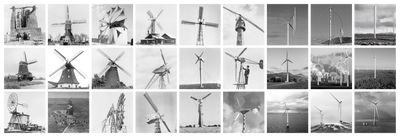
THE DISCOVERY OF WIND POWER
Source: Windkraftanlagen v. Erich Hau, 2017.
The Potential of Wind Energy
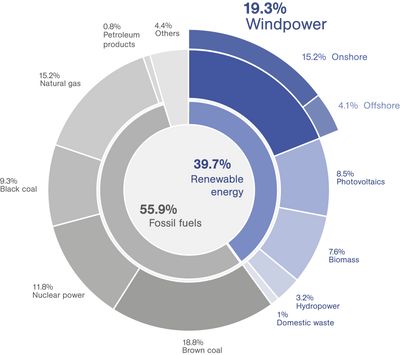
Wind energy is set to play a major role in the global strive to reach net zero. For Germany wind power could be the solution to reach their goals of 80 % renewable energy production by 2030. Today wind energy already provides the largest part of renewable energy in Germany. Therewith the nation has the third highest installed wind power capacity in the world.
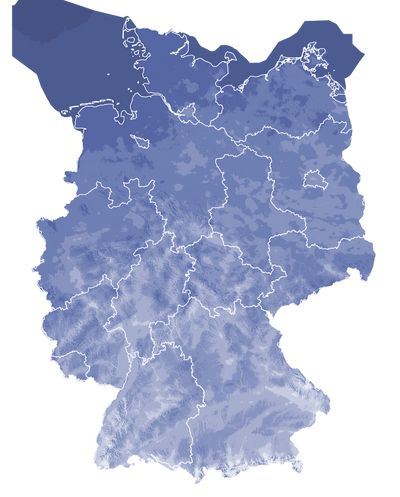
WIND POTENTIAL
Wind speed at 100 meters.
Source: EEG
- less than 4.0 m/s
- 4.0–5.0 m/s
- 5.0–6.0 m/s
- 6.0–7.0 m/s
- 7.0–8.0 m/s
- 8.0–9.0 m/s
- 9.0–10.0 m/s
- 10.0–11.0 m/s
- more than 11.0 m/s
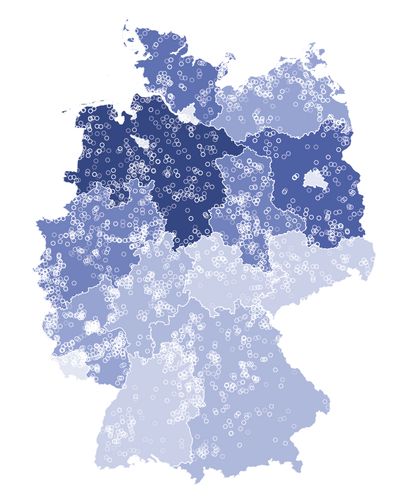
POWER CAPACITY THROUGH WIND ENERGY PER STATE
Source: EEG
 wind power plant
wind power plant- 0–1,000 MW
- 1,000–2,000 MW
- 2,000–3,000 MW
- 3,000–4,000 MW
- 4,000-5,000 MW
- 5,000–6,000 MW
- 6,000–7,000 MW
- 7,000–8,000 MW
- 8,000–9,000 MW
- 9,000–10,000 MW
- 10,000–11,000 MW
- more than 11,000 MW

CAPACITY THROUGH WIND ENERGY ADDITION PER STATE
The growth of capacity through wind turbines in planning.
Source: EEG
- 0–50 MW
- 50–100 MW
- 100–150 MW
- 150–200 MW
- more than 200 MW
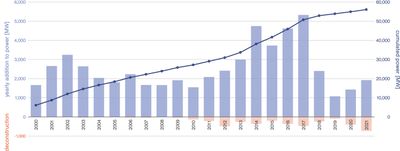
Source: BWE
Despite the widespread potential of wind energy, the increase in wind turbine construction has stagnated in recent years. This can be traced back to fewer sites designated to wind turbines. However, the energy goal of Germany is to double the amount of electricity generated from renewable energies by 2030. In this process wind energy plays an important role. Therefore, new policies are being implemented to structure the landscape and to support the extension of wind power.
The Wind Turbine: A History of Growth
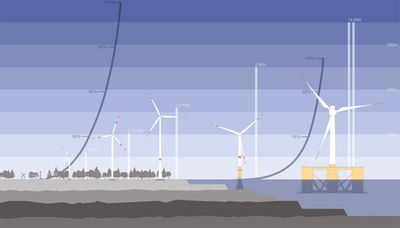
SIZE COMPARISON OF DIFFERENT WIND TURBINE TYPES
The blue graphs show the influence of different earth surfaces on the geostrophic wind. Greater friction will occur on rougher terrain compared to flat surfaces like the ocean.
The potential of wind energy and its use is not a new phenomenon. Wind-powered machines used to grind grain and pump water, the windmill and wind pump, were developed in what are now Iran, Afghanistan and Pakistan by the 9th century. The first windmills in Europe appear in sources dating to the twelfth century. By the 14th century Dutch windmills were in use to drain areas of the Rhine River delta. The first wind turbine used for the production of electricity was built in Scotland in July 1887.
Since then, power generation through the operation of windmills has evolved and has seen a surge in innovation, especially in recent decades, as wind energy has been recognised as an important element of the energy transition. Power output has increased by a factor of 50 in 30 years, in part due to a dramatic increment in height.

The diagram shows the annual and daily wind averages in the geographical area of our research. The highest values occur mostly in the colder months, while the diurnal variations have their peak at night.
Source: GWA
A disadvantage of using wind power is its intermittency. As soon as the wind stops blowing, the rotors will not turn further, and electricity is no longer produced. Unfortunately, this fact is unavoidable. Nonetheless, its potential during windy periods far exceeds the doldrums, considering that the blades start turning even at a relatively weak airflow.
The Wind Wheel: A Vertical Factory
The wind park Königshovener Höhe, which serves here as a case study, is located on recultivated grounds of a former open-mining pit in the Rheinische Revier in Germany. It is owned by the private energy company RWE and the city of Bedburg. The wind park is exclusively equipped with 21 Senvion 3.2M114 wind turbines with a hub height of 143 metres who span over an area of 300 hectares amounting to a potential 65 MW. Each turbine can supply about 2100 households with electric energy. For the production of one turbine vast amounts of concrete are needed to create the foundation. The tower is built as a so-called hybrid tower, thus the lower part is also made of concrete. Additional required resources are steel, iron, fibre and zinc, among others.

EXPLODED AXONOMETRY OF A SENVION 3.2M114 POWER PLANT
Material Flows in Wind Turbine Production
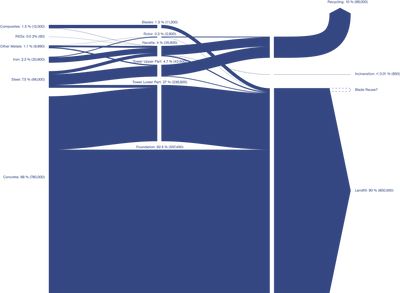
Source: Global Wind Report 2022
Raw Material Demand for Wind Turbines
Some parts of the wind turbine are easier to recycle than others. The steel components used in the tower, the nacelle and the rotor can be disassembled and recycled along with the alloy metals they contain. While the carbon fibre and epoxy blades can be broken down for reuse, it is not yet economically viable to do so, which is why they mostly end up in landfills. The concrete used in the lower tower and foundation is either left in the ground or carried off to some other dumping site. In both cases reusing might be a better alternative—like integrating the old foundation into a new one or reusing the fibre blades as public furniture in cities.
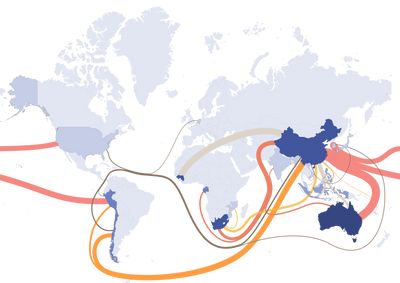
GLOBAL ORE-BASED MATERIAL TRADE PROPORTIONAL TO AMOUNT CONTAINED IN A WIND TURBINE
The darker the blue of a country, the larger its mining output of the listed metals.
Source: Statista
- Zinc
- Aluminum
- Copper
- Manganese
- Chromium
- Nickel
- Molybdenum
- Rare earth elements
- Zinc
- Aluminum
- Copper
- Manganese
- Chromium
- Nickel
- Molybdenum
- Rare earth elements
Once built, a wind turbine can function independently and autonomously for the most part. However, the supply chains of the processed materials are complex and global. While the different required metals are sourced in various parts of the world such as South America and Africa, the main player is China. It dominates with one of the largest domestic extraction and processing capacities, while also importing the most metals globally.

REFINED MATERIAL REQUIREMENT FOR WIND TURBINES IN GERMANY IN 2021 IN TONNES
- Zinc
- Aluminum
- Copper
- Manganese
- Chromium
- Nickel
- Molybdenum
- Rare earth elements
- Zinc
- Aluminum
- Copper
- Manganese
- Chromium
- Nickel
- Molybdenum
- Rare earth elements
Wind energy is not completely carbon neutral. The emissions generated during the sourcing, production and construction of the turbine define the total carbon output of average 11 grams of CO2 emission per kilowatthour of electricity generated. That compares with 44 g/kwh for solar, 450 g for natural gas, and 1,000 g for coal. The average lifespan of a wind turbine outlasts the carbon payback period by far.
A wind turbine can be optimised by increasing its size, which has a multitude of benefits: Due to the gain in height, it can profit from the faster and more constant wind at higher altitudes, while the doubling of the blade radius represents a quadrupling of the area swept by the rotor. This raises the power output while reducing the proportional carbon footprint. Also, fewer large turbines are less costly to maintain than many small turbines because there are ultimately fewer moving parts.
Negotiating Wind Territories in the Rheinland
The region of the Rheinland shows a relatively even distribution of wind potential. To harness this renewable energy wind turbines were exempted from certain regulations. Therefore, construction is permitted in the periphery. However, the sites for the actual wind turbine zones are still limited. Owing to federal, state and district codes imposing strict and differing guidelines.
Firstly, the urban protection zone alone excludes 90.7 % of North Rhine-Westphalia (NRW). As per the Federal Building Code (BauGB) the turbines have to be kept at a minimum distance of 1,000 m from residential areas with more than 20 buildings. Hence, inhabitants are protected from noise emissions, visual effects like shadow flickering, and visual oppression. Furthermore, infrastructures like federal streets, railways and grid infrastructure also include a safety buffer of 180 m. In addition, there is a multitude of ecologically protected areas. Including natural parks, nature reserves (NSG), the NATURA-2000 areas with the FFH-regions (Fauna-Flora-Habitat) and European bird conservation areas. Especially vulnerable animals such as birds and bats are exposed to new threats. The rapid change in air pressure can lead to harmful or even lethal collisions. However, these occurrences are relatively rare and do not threaten the population of the species. Still new measures could be considered, for instance turning off the turbines in accordance with animal migration patterns. Lastly the natural scenery of NRW has been divided up into four value categories varying from low to very high. This was based on a standardised method with different criteria such as uniqueness, diversity and beauty. A very high value level prevents construction of wind turbines. In contrast the other value levels permit such projects. Although a compensatory fee has to be paid which allows to preserve the landscape.
Consequently, after considering all those restrictions, only 2 % of the state is left for potential wind energy use. However, this area is further limited by the zoning plans of the districts, which designate allowed areas with the goal of concentrating wind turbine sites on a local level. Thus, the deciding factor in shaping the territory is not the potential energy by itself, but the complex interactions between local, regional and federal policies.
Windpark Site Comparison
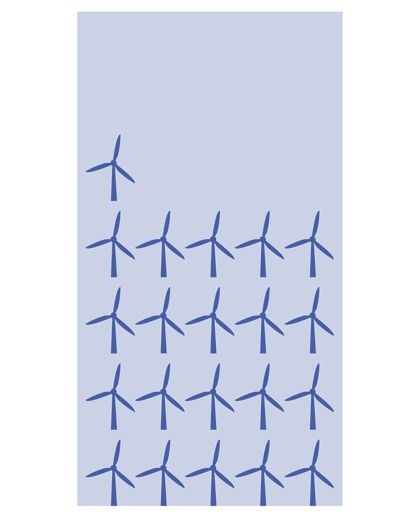
Power capacity of 66.5 MW

Power capacity of 20.5 MW
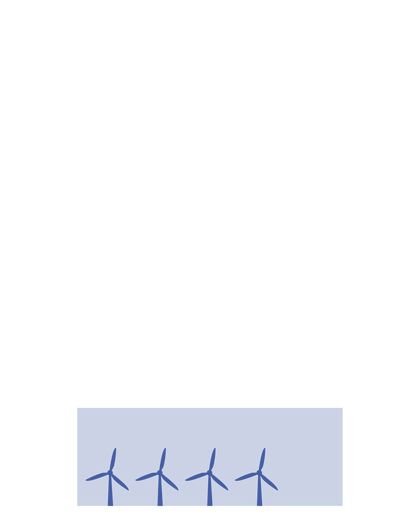
Power capacity of 13.2 MW

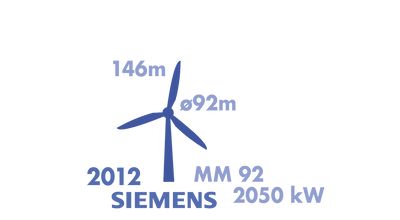
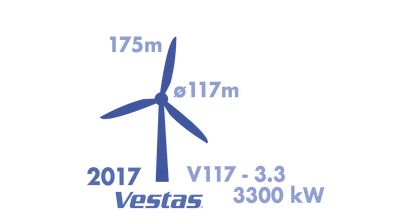
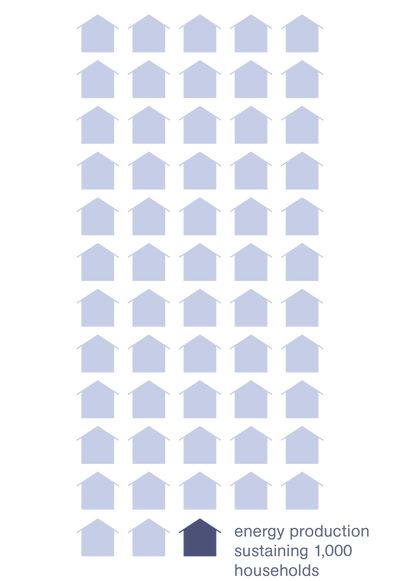
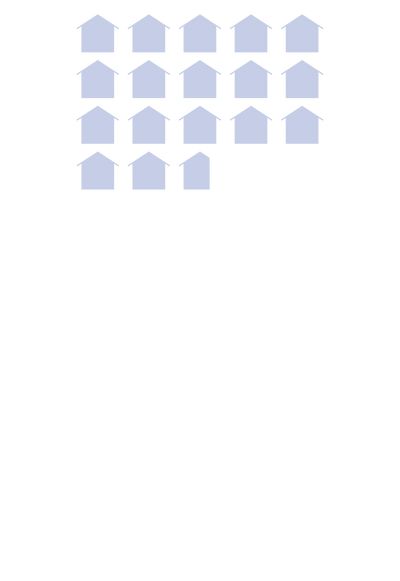
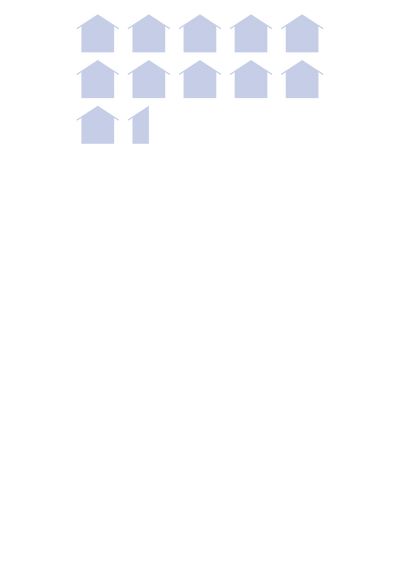
The ongoing task of producing energy has shaped the landscape of the Rheinland for centuries. The former open mining pit Garzweiler I has been recultivated and has now become a wind park: the recultivation led to an open and flat territory, creating ideal conditions for wind energy production. With punctual interventions arranged in a grid, wind turbines are superimposed on the territory and leave space in between for a multitude of activities and habitats.
























